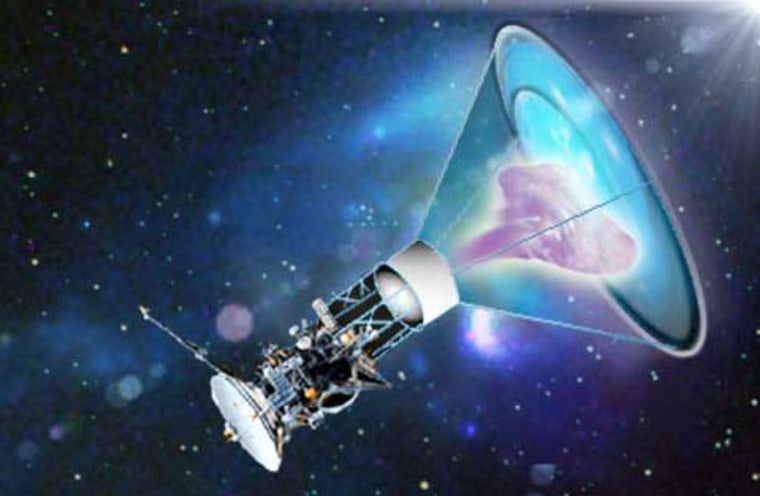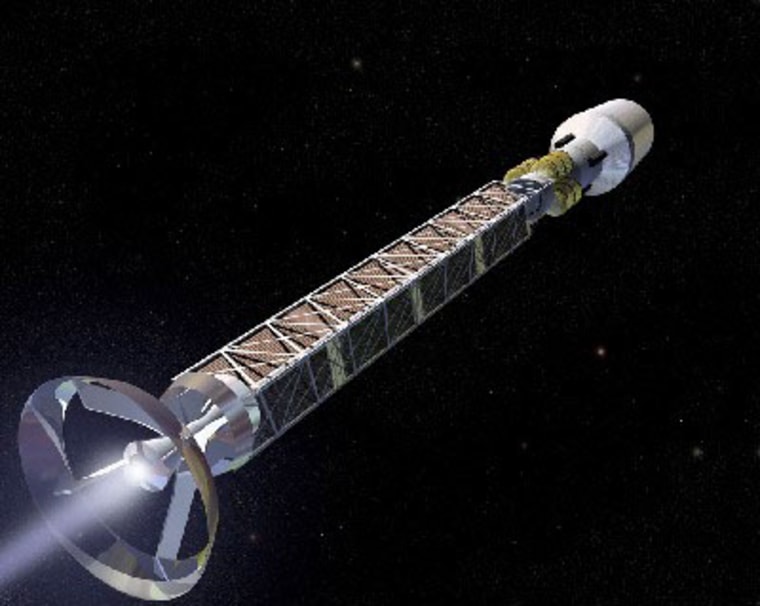If the nearest star system, Alpha Centauri, does harbor rocky planets similar to Earth as new findings suggest, there exist a host of ways to get us there, in theory.
Sending a person to Alpha Centauri within a human lifetime wouldn't be easy. Alpha Centauri is 4.37 light-years away — more than 25.6 trillion miles, or more than 276,000 times the distance from the Earth to the sun.
"Interstellar travel is extremely hard," said science fiction author and NASA physicist Geoffrey Landis.
But the lure has never been stronger. Scientists last week said the Alpha Centauri system has the ingredients for an Earth-like planet, and they think they can spot it.
Conventional rockets are nowhere near efficient enough. At a maximum speed of about 17,600 mph, it would take the space shuttle, for example, about 165,000 years to reach Alpha Centauri. In any case, "the problem with conventional rockets is that if you're carrying fuel, you need fuel just to carry all the fuel you bring with you, and it just gets exponentially worse," Landis said.
But antimatter engines might work. These drives rely on the extraordinary amount of energy released when antimatter and matter annihilate each other. The problem, however, is creating enough and storing any antimatter for the trip.
"All of the current methods of manufacturing antimatter require enormous particle accelerators and produce antimatter in very small quantities," Landis said. "And to store antimatter, if you need a ton of magnets for one gram of antimatter, the entire idea of a lightweight way to store immense amounts of energy is no longer lightweight."

Although one could in principle freeze anti-hydrogen and thus bypass the need for magnets, "if even the tiniest amount ever leaked out and touched the walls surrounding it, you'd produce a lot of heat, which in turn would heat up the frozen anti-hydrogen, and the whole thing catastrophically goes away," Landis said.
Antimatter could nevertheless perhaps find use in interstellar spaceships as a way to help trigger nuclear reactions. "That's something that hasn't been ruled out yet, and a little antimatter could help go a long way," Landis said.
Instead of rockets that carry all their fuel with them, spaceships might scoop it up along the way. One design proposed by physicist Robert Bussard (who died last year) would employ giant electromagnetic fields to suck in hydrogen to fuel a nuclear rocket.
Unfortunately, this "ramscoop" or Bussard ramjet, probably could not work. "The interstellar medium is not as dense as Bob Bussard thought it would be," Landis said. "And so far all attempts to design some kind of scoop had the unfortunate effect of producing more drag than you get back thrust, working kind of like parachutes."
Moreover, "we don't really have any notion of how to use the pure hydrogen we find in interstellar space as fusion fuel," Landis added. All of the proposals for fusion in the lab use deuterium-tritium (two isotopes of hydrogen) or deuterium with helium-3 (an isotope of helium) — "we don't have any suggestions for pure hydrogen in a fusion reaction," he said. "It was a clever idea, but the devil's in the details."
Sail away
Light sails might be another way to go — giant, thin, lightweight reflective sails that rely on the slight push provided by light beams. "The point is to not carry the energy you need for propulsion with you, but to get it transmitted to you," explained Jordin Kare, a Seattle-based technical consultant on advanced space systems.
Instead of relying just on the enormous amount of light given off by the sun, light sails to Alpha Centauri could also ride laser beams that earthlings would fire carefully at those ships to give an extra boost, especially when sails were too far away to catch much light from our sun.
The idea with a laser sail is that the sky is the limit in regards to speed. You just keep accelerating, albeit gradually.
The problem with interstellar travel with laser sails is that a lot of light needs to be used for a long time to get fast enough to get to Alpha Centauri within a human lifetime. This means very powerful and extraordinarily large lasers are needed in order to focus on sails that get farther and farther away, Kare explained.
An idea similar to light sails that Landis helped come up with involved firing a particle beam at a spaceship that would ride that energy. "The problem with laser beams is that they disperse over distance, so we thought about particle beams," Landis explained. The beam would have to have a neutral electrical charge so as not to disperse itself over time. "It would be a feasible idea," he said.
Bombs away!
Another idea for space travel would involve riding explosions through space. Such "pulsed propulsion" would hurl bombs behind a ship, which is shielded with a giant plate. The explosions would push against the plate, propelling the ship. Project Orion suggested using nuclear bombs, while other proposals have since proposed smaller explosives.

A variant on both the laser sail and pulsed propulsion idea that Kare came up with was the "sail beam." Essentially, a laser would propel lots of miniature sails like bullets at a distant ship. The impact of these sails would propel the spacecraft.
"The idea is to get a craft up to about a tenth of the speed of light that way," Kare said. "It could get you to Alpha Centauri in 60 to 70 years."
So far no one has created technology that is widely agreed upon as capable of caring for or preserving humans across the lifetimes it might take to get to Alpha Centauri. It might easily take more than one lifetime to reach the star system — one antimatter engine design would take 200 years to send humans there. If that proves so, mission designers might have to take sex and family into account so offspring of the original crew would be around at the end of the trip, unless someone successfully invents a technique for placing people in suspended animation.
Then again, warp drives and similar far-out ideas might one day zip us faster than light to Alpha Centauri and beyond. "We don't know all the physics there is to know yet, and something we don't know yet might give us tremendous capabilities," Landis said.
